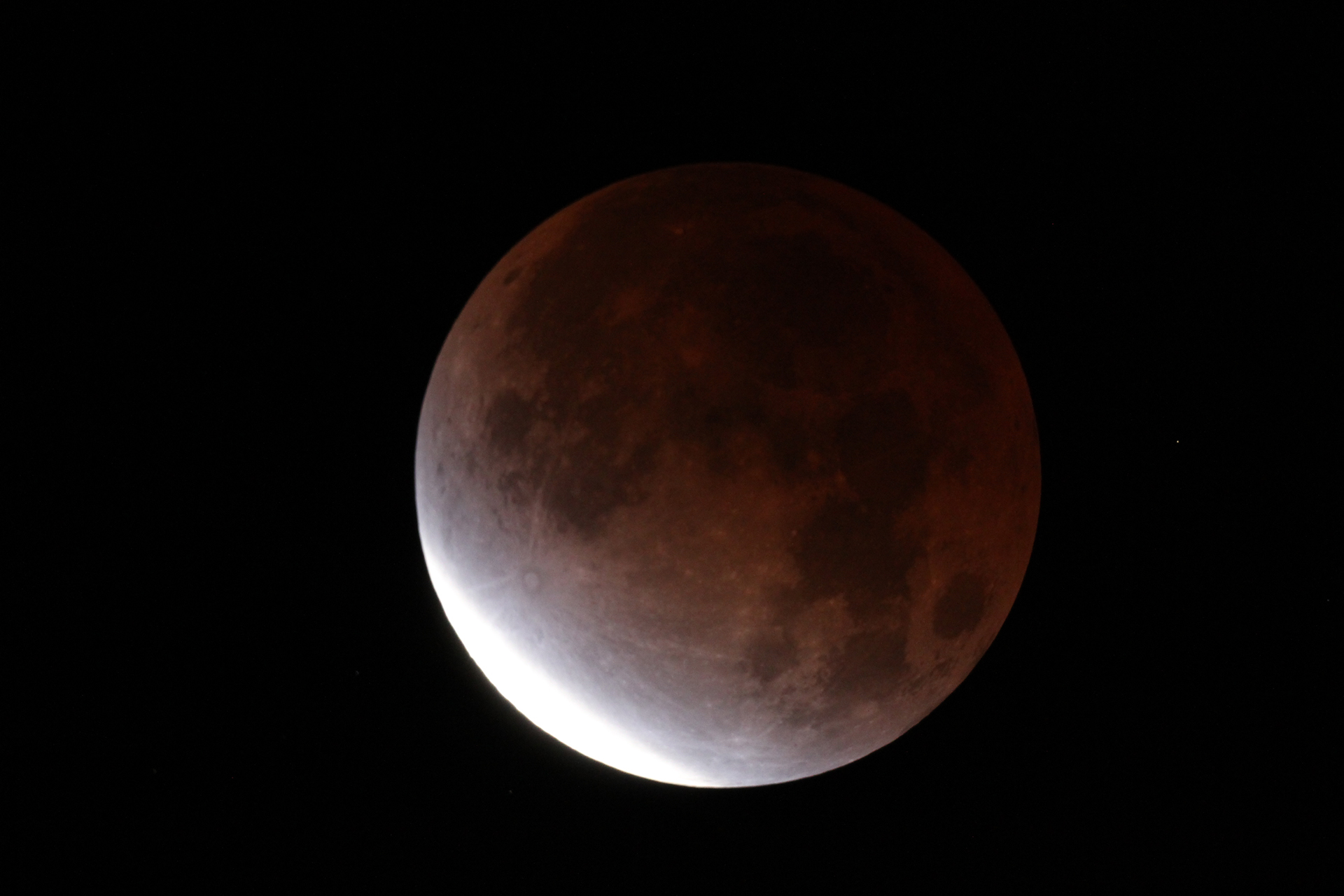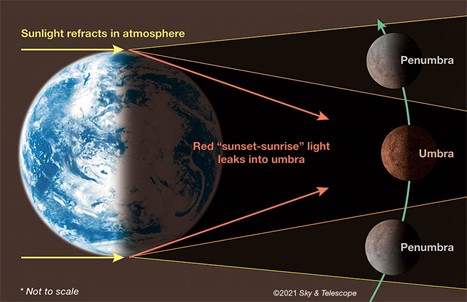May 15th’s “Full Super Flower Blood Moon”

The near-total lunar eclipse, last November 19. Photo by our Sky Ranger.
They aren’t nearly the equal of a total eclipse of the Sun, but after more than fifty years of sky watching, I still get a kick out of watching lunar eclipses. This is because no two of them are exactly alike, and little or no equipment is needed to see them. In addition, since lunar eclipses are visible from anywhere in the world where the Moon is above the horizon, they are relatively common, so if the sky happens to be cloudy, it is a disappointment but not a tragedy. I hope that I just didn’t jinx this one- but if I did, there will be another chance on November 8. The catch is that the maximum will take place at about 5:00 AM.
The moon’s orbit around the Earth is tilted slightly relative to the plane between the Earth and Sun. Twice a month, the Moon passes through the node, where it temporarily is exactly in the plane. If this happens when the Moon is also directly in line with the Earth and Sun, there will be an eclipse. If the alignment is Sun-Moon-Earth, there will be a solar eclipse, where the Moon casts its shadow on Earth. If the line-up is Sun-Earth-Moon, it will be the Moon that is eclipsed in Earth’s shadow. Depending upon the degree of perfection of the alignment, an eclipse can be partial or total, and can last for a longer or shorter amount of time.

Earth’s umbral shadow usually causes the Moon to appear reddish when totally eclipsed, but each event can be quite different. Courtesy of Sky & Telescope magazine.
Total eclipses of the Moon are often termed “blood moons,” since some light refracts around the edge of the Earth and faintly lights up the shadowed part of the Moon. It usually does look reddish-orange, but depending upon the overall clarity of Earth’s atmosphere, during a total eclipse, the umbral shadow can look like anything from a shiny new penny to a spooky, dark orb. Some experts believe that the May 15 eclipse may look darker than normal, due to the effects of the volcano in Tonga, but there is only one way to find out- take a look! The term “blood moon” is of relatively recent origin and is not official or scientific.
Similarly, the term “supermoon” seems to have become popular in recent years, referring to a moon that is both full and near its perigee, or closest point to the Earth. This is really not that big of a deal- at most, the Full moon appears 14% larger and 30% brighter if “super” as opposed to “micro.” This is noticeable but far from overwhelming. May’s perigee occurs two days after the eclipse, so to me it is stretching it slightly to call it a “supermoon,” but I’m sure the media will call it that anyway. Finally, most full moons have names, given to it by various cultures, and the traditional American name for May is appropriately enough, the “Flower Moon.” I have already seen a number of sources call the upcoming eclipse the “Full Super Flower Blood Moon.”
One nice thing about May’s eclipse is that unlike that of last November or this November, it happens at a relatively convenient time of night. As can be seen from the chart, the Moon will begin to enter Earth’s darker umbral shadow at 9:27 pm on Sunday, May 15. A slight shading, caused by the outer penumbral shadow, might be a bit noticeable 15 or 20 minutes before this time, but the umbra will be quite obvious. As more and more of the moon is covered by the Earth’s shadow, stars too dim to be seen through full moonlight will begin to be seen, and depending upon the degree of darkness of the umbra, some redness may be seen. Binoculars or a small telescope improve the view but are not essential, and the eclipse could be a good photo subject. Although cell phone cameras are not made for this sort of photography, try playing with your focus and exposure settings to see what you can get. It is also helpful, especially at or near totality, to prop your arms up on something or to place your camera on a tripod in order to hold it steady, with the moon so much dimmer than normal. Since the shadow caused by the Earth is so large, the total phase will last 84 minutes, from 10:29-11:53 pm, whereas a total eclipse of the Sun can last at most 7 ½ minutes, with most much shorter than that.
As bright as it is, the full moon shines about 400,000 times dimmer than direct sunlight, and it will be dimmed even more by the eclipse, so it will be perfectly safe to look at the May 15 eclipse. If the night is clear and your kids are old enough, I might suggest keeping them up until the maximum, around 11:11 pm, as everything that happens after is that is simply a repeat of the first half of the eclipse, in reverse order. Send any pictures or reports of the eclipse to the Gateway Arch NPS Facebook page, or e-mail me at richard_fefferman@nps.gov.
TOTAL ECLIPSE OF THE MOON, MAY 15
9:15 pm Slight penumbral shading??
9:27 pm Moon enters umbra
10:29 pm Total eclipse begins
11:11 pm Maximum Eclipse
11:53 pm Total eclipse ends
12:55 am Moon leaves umbra
All times correct for St. Louis
Our first Gateway to the Stars program for this summer will take place on Saturday evening, May 28. St. Louis Astronomical Society President James Small will discuss “The Globe at Night”, an initiative in which you can help measure the light pollution in your area, using only a smartphone or tablet. This is an in person FREE program and will take place at 6:45 pm in the Education Classroom in the Gateway Arch Visitor Center, regardless of the weather. If skies are at least decently clear, “The Globe at Night” will be followed by free telescope viewing out on our West Entrance Plaza, led by volunteers from the St. Louis Astronomical Society.
